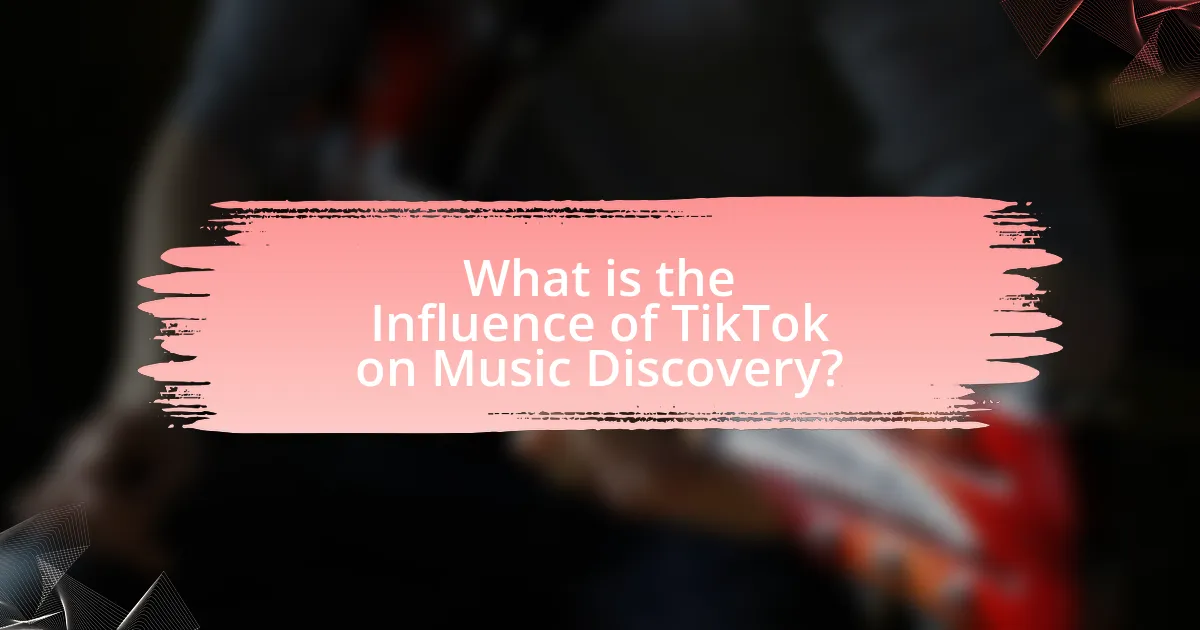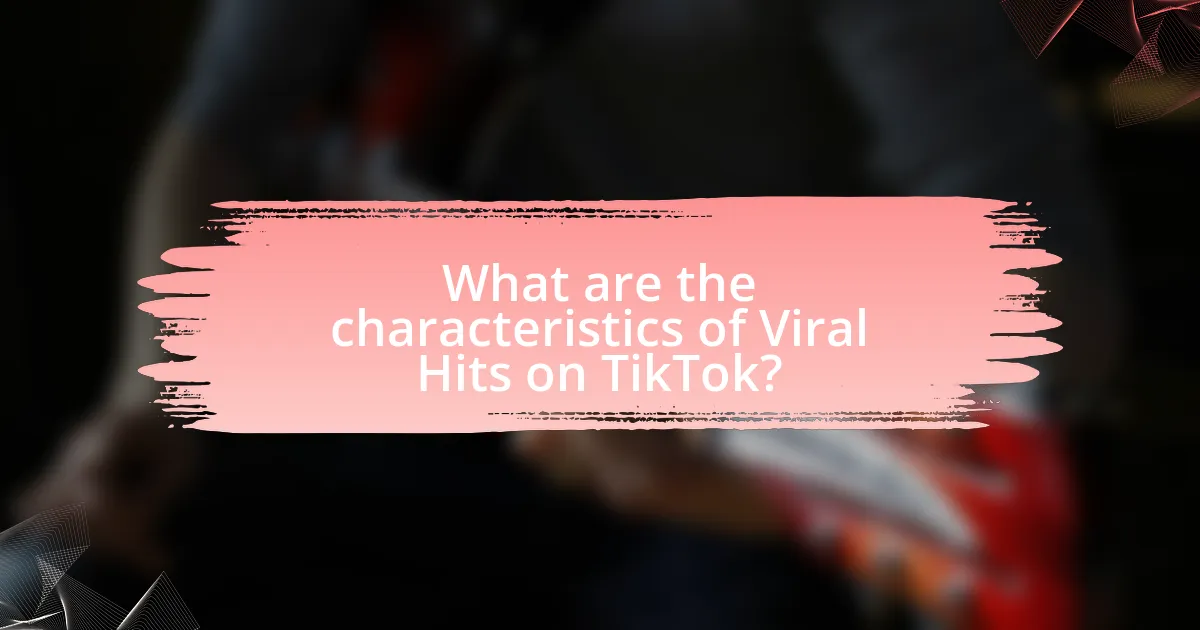The article examines the significant influence of TikTok on music discovery, highlighting how the platform enables songs to go viral through user-generated content and trends. It discusses the role of TikTok’s algorithm in promoting tracks based on engagement, leading to increased streams and chart success for emerging artists. Key examples, such as “Savage Love” by Jawsh 685 and Jason Derulo, illustrate how viral challenges and dances can propel songs to the top of music charts. The article also explores the implications of TikTok’s impact on marketing strategies for record labels and the challenges artists face in maintaining authenticity while navigating the platform’s rapidly changing landscape.

What is the Influence of TikTok on Music Discovery?
TikTok significantly influences music discovery by enabling songs to go viral through user-generated content and trends. The platform’s algorithm promotes tracks that are used in popular videos, leading to increased streams and chart success. For instance, songs like “Savage Love” by Jawsh 685 and Jason Derulo gained immense popularity after being featured in viral TikTok dances, resulting in the song reaching number one on the Billboard Hot 100. Additionally, a report from the NPD Group indicated that 67% of TikTok users discover new music on the app, showcasing its role as a primary tool for music discovery among younger audiences.
How has TikTok changed the landscape of music discovery?
TikTok has transformed the landscape of music discovery by enabling songs to go viral through short, engaging video clips. This platform allows users to create and share content that often features snippets of songs, leading to increased exposure and popularity for emerging artists. For instance, tracks like “Savage Love” by Jawsh 685 and Jason Derulo gained significant traction after being featured in viral TikTok dances, resulting in chart-topping success. Additionally, TikTok’s algorithm promotes music based on user engagement rather than traditional metrics, allowing lesser-known artists to reach wider audiences quickly. This shift has fundamentally altered how listeners discover and interact with music, making TikTok a pivotal player in the modern music industry.
What role does user-generated content play in music discovery on TikTok?
User-generated content is crucial for music discovery on TikTok, as it drives engagement and promotes songs through creative user interactions. When users create videos featuring specific tracks, they often set trends that can lead to viral challenges or dances, significantly increasing a song’s visibility. For instance, the song “Savage Love” by Jawsh 685 and Jason Derulo gained immense popularity after users created dance routines, leading to over 1 billion views on TikTok. This phenomenon illustrates how user-generated content not only enhances the reach of music but also influences chart performance, as songs featured in popular TikTok videos frequently climb music charts, demonstrating the platform’s power in shaping music trends.
How do TikTok trends influence music charts and streaming platforms?
TikTok trends significantly influence music charts and streaming platforms by driving viral engagement and increasing song visibility. When a song becomes popular on TikTok, it often leads to a surge in streams on platforms like Spotify and Apple Music, as evidenced by the Billboard Hot 100, where tracks that gain traction on TikTok frequently enter the charts. For instance, in 2020, the song “Savage Love” by Jawsh 685 and Jason Derulo climbed to the top of the Billboard charts largely due to its viral dance challenge on TikTok, demonstrating the platform’s power in shaping music consumption patterns. This phenomenon occurs because TikTok’s algorithm promotes catchy and engaging content, encouraging users to share and create videos that feature specific songs, which in turn boosts those songs’ popularity across streaming services.
Why is TikTok a powerful tool for emerging artists?
TikTok is a powerful tool for emerging artists because it provides a platform for viral exposure and audience engagement. The app’s algorithm promotes content based on user interaction rather than follower count, allowing new artists to reach millions quickly. For instance, songs like “Savage Love” by Jawsh 685 and Jason Derulo gained immense popularity after being featured in viral TikTok challenges, demonstrating how the platform can catapult tracks into mainstream success. Additionally, TikTok’s user base, predominantly composed of younger demographics, actively seeks fresh and innovative music, making it an ideal space for emerging artists to showcase their work and connect with potential fans.
What features of TikTok contribute to its effectiveness in promoting new music?
TikTok’s effectiveness in promoting new music is primarily driven by its algorithm, user-generated content, and viral challenges. The algorithm curates personalized content for users, ensuring that trending songs reach a wide audience quickly. User-generated content allows creators to incorporate music into their videos, leading to organic exposure and engagement. Viral challenges, often centered around specific songs, incentivize users to participate and share, further amplifying the reach of new music. For instance, songs like “Savage Love” by Jawsh 685 and Jason Derulo gained immense popularity after being featured in viral TikTok dances, demonstrating the platform’s ability to propel tracks into mainstream success.
How do viral challenges and dances impact song popularity?
Viral challenges and dances significantly enhance song popularity by creating engaging content that encourages user participation and sharing. When a song is associated with a viral challenge, it often leads to increased visibility on platforms like TikTok, where users create and share videos featuring the song. For instance, the song “Savage Love” by Jawsh 685 and Jason Derulo gained immense popularity after a dance challenge went viral on TikTok, resulting in the song reaching number one on the Billboard Hot 100 chart. This phenomenon illustrates how the integration of music with viral trends can drive streaming numbers and chart performance, as songs featured in popular challenges often see a spike in plays and downloads.

What are the characteristics of Viral Hits on TikTok?
Viral hits on TikTok are characterized by their catchy melodies, relatable content, and strong visual elements. Catchy melodies often lead to easy recall and encourage users to create their own content, while relatable content resonates with a wide audience, fostering engagement. Strong visual elements, such as unique choreography or striking visuals, enhance shareability and encourage users to participate in trends. According to a study by the University of Southern California, songs that go viral on TikTok typically see a significant increase in streaming numbers, demonstrating the platform’s influence on music discovery and consumption.
What elements make a song go viral on TikTok?
Catchy hooks and relatable lyrics are the primary elements that make a song go viral on TikTok. Songs that feature short, memorable phrases or beats encourage users to create content around them, leading to widespread sharing. Additionally, songs that align with trending challenges or themes on the platform, such as dance trends or emotional moments, significantly increase their chances of virality. For instance, the song “Savage Love” by Jawsh 685 and Jason Derulo gained immense popularity due to its catchy hook and association with a viral dance challenge, resulting in over 1 billion views on TikTok. This demonstrates how specific musical elements and their integration into user-generated content can drive a song’s success on the platform.
How does song length affect its potential for virality on the platform?
Song length significantly affects its potential for virality on TikTok, with shorter songs generally having a higher likelihood of becoming viral hits. Research indicates that tracks around 15 to 30 seconds long are optimal for TikTok, as they align with the platform’s format that encourages quick, engaging content. For instance, a study by the University of Southern California found that songs under 30 seconds are more frequently used in user-generated content, leading to increased shares and engagement. This trend suggests that shorter songs facilitate easier incorporation into challenges and trends, enhancing their chances of going viral.
What genres are most commonly associated with viral hits on TikTok?
The genres most commonly associated with viral hits on TikTok are pop, hip-hop, and dance. Pop music dominates the platform due to its catchy melodies and broad appeal, while hip-hop often features trending challenges and dance routines that engage users. Dance music, characterized by its upbeat tempo, is frequently used in videos that encourage choreography, further driving its popularity. According to a report by the music analytics firm Chartmetric, tracks in these genres consistently achieve higher engagement rates and are more likely to trend on TikTok, reinforcing their association with viral success.
How do TikTok users engage with viral music content?
TikTok users engage with viral music content primarily through creating and sharing short videos that incorporate popular songs, often using specific challenges or trends associated with those tracks. This engagement is facilitated by the platform’s algorithm, which promotes content that resonates with users, leading to increased visibility and interaction. For instance, a study by the University of Southern California found that songs featured in viral TikTok videos can experience a significant boost in streaming numbers, with tracks like “Savage Love” by Jawsh 685 and Jason Derulo seeing a 1,000% increase in Spotify streams after going viral on the platform. This demonstrates that TikTok not only serves as a medium for music discovery but also directly influences the commercial success of songs.
What types of user interactions contribute to a song’s virality?
User interactions that contribute to a song’s virality include sharing, creating content, and engaging with the song through comments and likes. Sharing a song across social media platforms amplifies its reach, while user-generated content, such as dance challenges or lip-sync videos, encourages further engagement and visibility. Engagement metrics, like comments and likes, indicate popularity and can trigger algorithmic boosts on platforms like TikTok, leading to increased exposure. For instance, songs that become part of trending challenges often see a significant rise in streams and downloads, demonstrating the direct correlation between user interactions and a song’s virality.
How does the TikTok algorithm promote certain songs over others?
The TikTok algorithm promotes certain songs over others primarily through user engagement metrics such as likes, shares, and comments. Songs that generate higher engagement are more likely to be featured in users’ feeds, leading to increased visibility and virality. For instance, a song that is used in multiple trending videos will gain traction as the algorithm prioritizes content that resonates with users, thereby amplifying its reach. Additionally, TikTok’s algorithm considers factors like the completion rate of videos and the frequency of a song’s use in popular challenges, which further influences which songs are promoted. This data-driven approach ensures that songs that capture user interest are consistently highlighted, driving their popularity on the platform.
What are the implications of TikTok’s influence on the music industry?
TikTok’s influence on the music industry has significantly altered how songs are discovered and promoted. The platform’s algorithm-driven content distribution allows tracks to go viral rapidly, leading to increased streaming numbers and chart success for artists. For instance, songs like “Savage Love” by Jawsh 685 and Jason Derulo gained immense popularity after trending on TikTok, resulting in the song reaching number one on the Billboard Hot 100. This phenomenon demonstrates that TikTok can propel lesser-known artists into mainstream success, reshaping traditional marketing strategies in the music industry. Additionally, the platform has created a new avenue for music promotion, where short, engaging clips can lead to significant audience engagement and revenue generation, highlighting the evolving landscape of music consumption.
How has TikTok reshaped marketing strategies for record labels?
TikTok has reshaped marketing strategies for record labels by prioritizing short-form video content that drives viral trends and music discovery. Record labels now focus on creating engaging, shareable content that resonates with TikTok’s user base, leveraging challenges, dances, and memes to promote songs. For instance, songs like “Savage Love” by Jawsh 685 and Jason Derulo gained immense popularity after being featured in viral TikTok videos, leading to significant chart success. This shift emphasizes the importance of social media engagement over traditional marketing methods, as TikTok’s algorithm allows songs to reach a vast audience quickly, making it a critical platform for launching new music.
What new opportunities does TikTok create for music promotion?
TikTok creates new opportunities for music promotion by enabling artists to reach vast audiences through short, engaging video content. The platform’s algorithm promotes viral trends, allowing songs to gain traction quickly when paired with popular challenges or memes. For instance, tracks like “Savage Love” by Jawsh 685 and Jason Derulo gained significant popularity after being featured in viral TikTok dances, leading to chart-topping success. Additionally, TikTok’s user-generated content encourages organic sharing, which can amplify an artist’s reach without traditional marketing costs. This unique blend of creativity and community engagement positions TikTok as a powerful tool for music discovery and promotion.
How do artists leverage TikTok to build their fanbase?
Artists leverage TikTok to build their fanbase by creating engaging short-form videos that showcase their music, often using popular trends and challenges to increase visibility. This platform allows artists to reach a vast audience quickly; for instance, songs that go viral on TikTok can lead to significant streaming increases, as seen with tracks like “Savage Love” by Jawsh 685 and Jason Derulo, which gained immense popularity after being featured in numerous TikTok videos. Additionally, artists interact directly with fans through comments and duets, fostering a sense of community and encouraging user-generated content that further promotes their music.
What challenges do artists face in the TikTok-driven music landscape?
Artists face several challenges in the TikTok-driven music landscape, primarily related to the platform’s algorithm and the rapid pace of trends. The algorithm favors short, catchy snippets, which can pressure artists to create music that fits this format rather than expressing their full artistic vision. Additionally, the constant influx of new trends can make it difficult for artists to maintain relevance, as songs can quickly go viral and then fade away, leading to a lack of sustained success. Furthermore, artists often struggle with monetization, as the virality of a song does not always translate into financial gain, and they may find it challenging to convert TikTok popularity into long-term fan engagement and sales.
How can artists maintain authenticity while participating in trends?
Artists can maintain authenticity while participating in trends by integrating their unique style and personal narrative into the trending elements. This approach allows artists to engage with popular trends without compromising their artistic identity. For instance, artists like Lil Nas X successfully blended country music with hip-hop elements in “Old Town Road,” which resonated with both traditional and contemporary audiences, showcasing how authenticity can coexist with trend participation. By doing so, artists not only attract a wider audience but also reinforce their individual brand, ensuring that their work remains true to their vision while still being relevant in the current cultural landscape.
What risks are associated with relying on TikTok for music success?
Relying on TikTok for music success poses several risks, including volatility in trends, algorithm dependency, and audience engagement challenges. The rapid nature of TikTok trends can lead to fleeting popularity, where a song may go viral one moment and be forgotten the next, as evidenced by the short lifespan of many viral hits. Additionally, artists become heavily dependent on TikTok’s algorithm, which can change unpredictably, affecting visibility and reach. Furthermore, while TikTok can generate initial interest, sustaining a loyal fanbase often requires deeper engagement beyond the platform, which may not always translate from viral success.
What best practices can artists follow to maximize their success on TikTok?
Artists can maximize their success on TikTok by consistently creating engaging, high-quality content that resonates with their target audience. Engaging content often includes trending challenges, original music, and relatable storytelling, which can increase visibility and encourage shares. Additionally, artists should leverage TikTok’s algorithm by posting regularly, ideally at peak times when their audience is most active, to enhance discoverability. Collaborating with other creators can also expand reach, as partnerships introduce artists to new followers. Utilizing relevant hashtags and participating in trending topics can further boost engagement and visibility. According to a study by the University of Southern California, artists who engage with their audience through comments and live sessions see a 30% increase in follower retention, highlighting the importance of interaction in building a loyal fan base.
How can artists effectively engage with their audience on the platform?
Artists can effectively engage with their audience on TikTok by creating authentic, relatable content that resonates with users. This approach is supported by the platform’s algorithm, which favors genuine interactions and encourages users to share content that reflects their personal experiences. For instance, artists who participate in trending challenges or use popular sounds can increase their visibility and foster a sense of community. Additionally, engaging directly with fans through comments and live streams enhances connection and loyalty, as evidenced by the success of artists like Lil Nas X, who utilized TikTok to promote his music and interact with followers, leading to significant viral hits.
What strategies can be employed to create shareable content on TikTok?
To create shareable content on TikTok, utilize trends, engage with challenges, and leverage music effectively. Trends are crucial as they encourage users to participate and share their versions, increasing visibility; for instance, TikTok’s “Renegade” dance became viral due to its widespread adoption. Engaging with challenges invites user interaction, fostering a sense of community and prompting shares; the “Ice Bucket Challenge” exemplifies how participation can lead to massive sharing. Additionally, leveraging popular music tracks enhances relatability and encourages users to create content that resonates with their audience, as seen with songs like “Savage Love” gaining popularity through user-generated content. These strategies collectively enhance the likelihood of content being shared on the platform.


